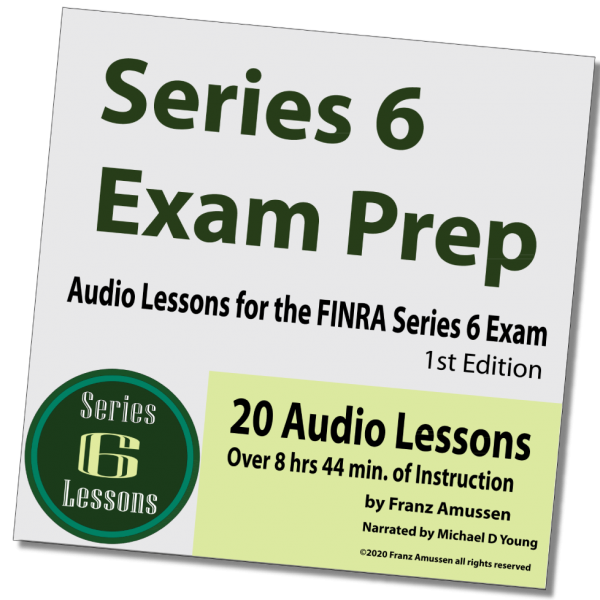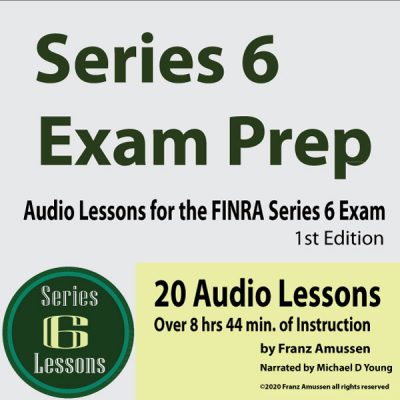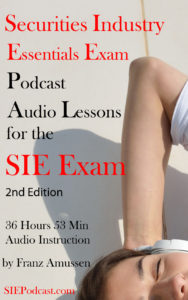Series 6 Lesson 12 Secondary Markets
Series 6 Lesson 12 Secondary Markets is this podcasts subject. The secondary market is for people to buy and sell securities to each other. The “first market” they are sold at is called the auction market. The main part of this is the New York Stock Exchange (NYSE), but there are also regional exchanges in Chicago, Boston, Philadelphia and San Francisco.
The second market is known by the names Over the Counter Market (OTC) or the negotiated market. This market shares round lots of 100 shares of stock and is done at individual computers and devices instead of a physical building. NASDAQ is one such market. If a stock does not trade on NASDAQ, it will not be as liquid or desirable.
The 3rd market is when there is an OTC transaction of a NYSE-listed security.
The 4th market is direct institutional trading.
GDP is the gross domestic product or the total output of the economy. If it is increasing, the economy is growing and vice versa. The economy goes through a series of growing and shrinking actions called the business cycle: expansion, peak, contraction, trough, recovery. A downward turn is known as a recession, and a longer recession becomes a depression.
Inflation is when prices rise too quickly. It is measured by the consumer price index, (CPI) which surveys prices customer are paying for common goods, such as groceries, gas, and clothing and compares them. This is known as “too many dollars chasing too many goods”.
The opposite of inflation is deflation where goods become too cheap and businesses cannot make a profit.
The Federal Reserve Board is always raising and lowering the interest rate in order to grow or shrink the economy as a way to keep it closer to a state of balance. This is known as monetary policy. They can also change the reserve requirement, which is the amount of money that banks are required to keep in reserve. This changes the amount of money that banks have available to lend, etc. They can also change the discount rate, which is the rate that the Federal Reserve charges to banks that borrow from it. Banks lends money to each other at the fed funds rate. The banks will then pass the higher or lower costs to their customers.
Fiscal policy refers to what the President and Congress do to affect the economy. To grow the economy, they can cut taxes and increase government spending. If they want to shrink the economy, they can increase taxes and cut government spending.
The Call money rate is the rate broker-dealers pay when borrowing money on behalf of their margin clients.
The prime rate is the rate at which the best qualified corporate clients get when borrowing money.
There are certain ways to invest that are known as tax advantaged. These are often used for retirement savings. Taxes usually eventually come due, but they can be deferred for a long time.
For profit companies offer 401k plans and schools/charities offer 403b plans. It is a tax-sheltered annuity. They indicate how much of their paycheck should go into the account. It gives you a tax break now and saves for retirement later. The employer usually matches the contribution up to a certain amount.
One type is called an IRA or Individual Retirement Account. There are several kinds of these.
A traditional IRA can be contributed to by anyone who is 70.5 years old or younger. You can put up to 100% of your earned income into the account. If you are past 50, you can contribute more. Contributions are pre-tax, which means that they are tax deductible from your income, which reduces the burden.
If you take out money from your IRA before 50.5 years old, you will take a 10% penalty. There is also a penalty of 6% if you overfund your IRA.
A Roth IRA is made with after-tax, non-deductible contributions. The money comes out tax free after age 59.5 and you have had the account for at least five years. If your income gets over a certain threshold, you will not be able to contribute to your Roth IRA for that year.
You can convert a traditional IRA to a Roth IRA by paying the current taxes owed on the money.
A defunded contribution plan is one in which the person’s employee makes a defined contribution to their retirement plan. A profit sharing plan is one that are flexible. The company can decide to contribute or not, but if they do, they have to contribute to all eligible employees according to company guidelines. In a money purchase plan, the employer is required to contribute and the employee is not required to contribute.
Section 457 plans are retirement plans for state or local government employees. Contributions are tax deductible. They have the same limits as 401k or 403b plans.
A SEP (Simplified Employee Pension) IRA is one where a traditional IRA account is set up for a self employed person or business owner and his or her employees. This has to be set down in a formal written agreement.
A SIMPLE IRA plan is another retirement solution for companies who have no other retirement plan and no more than 100 employees. It also has a formal agreement about how much employees have to make and how long they have to be with the company. The employees specify a percentage of their income to be deferred into their IRA plan. These can be matched with employer contributions.
These self-employed plans are sometimes known as Keogh plans.
A payroll deduction IRA has an employee say how much of their paycheck should go into the account. The employer does not contribute anything.
A defined benefit plan is the opposite of a defined contribution plan. For the contribution plan, the employer puts in a defined amount of money and then lets you off to your own devices. In the defined benefit plan, the employer sets down how much you will obtain per month at the beginning of the plan. It could perhaps be a percentage of your salary for the rest of your life. This is expensive for employers and so most retirement plans are defined contribution.
A 529 Plan allows a person to put money away to save for future education expenses. The money is invested in various mutual funds. You can also buy a 529 prepaid tuition plan, where you purchase tuition credits now which can be used later, even when tuition might be more expensive. The contributions are made after tax and are non-deductible. Withdrawals for educational purchases are exempt from federal taxes., though they may not be exempt from state taxes.
A Coverdell Education Savings Account (CESA) allows for after-tax contributions, but you only have a maximum of a few thousand dollars per child per year. These accounts can be used for any level of educational expenses tax free. The payments into the account have to stop on a person’s 18th birthday, and they have to be used by age 30 or be subject to a 10% fine.
Heath Savings Accounts (HSA) can be made to pay for medical expenses. The contributions are deductible and withdrawals to pay for medical expenses are tax free. It is tied to a high-deductible health plan.
Series 6 Lesson 12 Secondary Markets
We also offer lessons for:
The Series 7 Exam
https://gumroad.com/l/ILYu
The Series 22 Exam
https://series6lessons.com/series-22-exam/
The Series 63 Exam
https://series6lessons.com/series-63-exam-lessons/
The Life Health Insurance Exam
https://series6lessons.com/insurance-lessons/
The SIE Exam (Securities Industries Essentials Exam)
https://series6lessons.com/finra-sie/
Click on any of them to find out more
Podcast: Play in new window | Download (Duration: 10:51 — 4.5MB)
Subscribe: Apple Podcasts | RSS | Subscribe to Podcast




